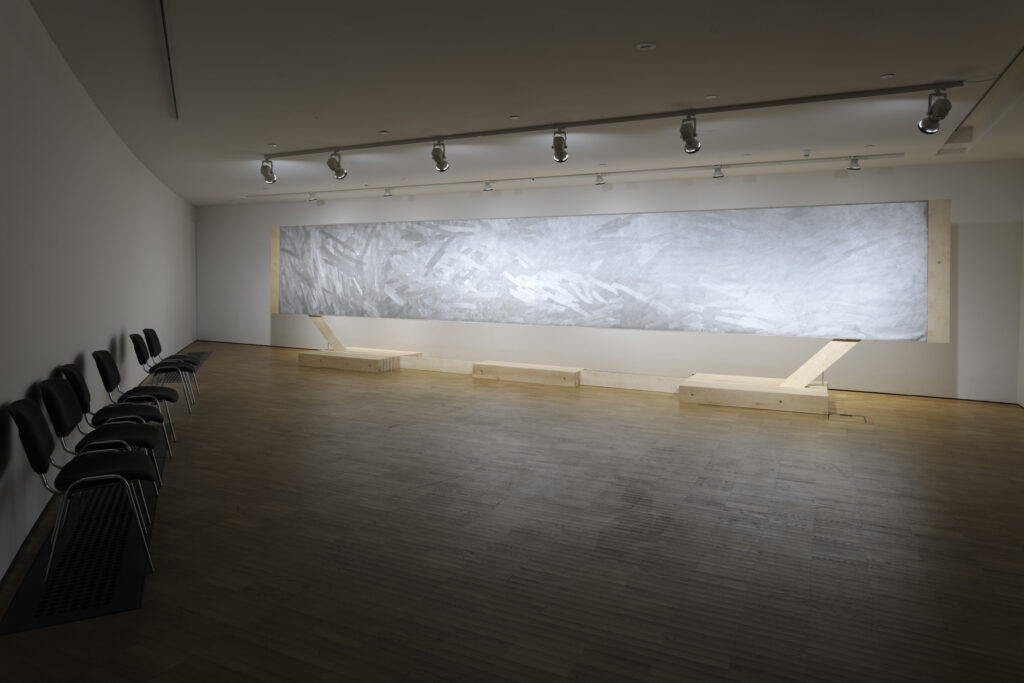
Sirje Runge (1950) is a painter and designer, recognised for her geometric abstract and minimalist paintings. In her earlier work Runge combined geometric balance and disciplined expressions to create repetitions of geometric shapes. In parallel to her interest in geometric elements the artist also has a deep interest in colour, which, over time, has become the main focus of her work.
Runge belongs among the artists who in the beginning of the 1970s created the new and more radical wave of Estonian avant-garde art. During this decade, as Runge was finding herself as an artist, she was experimenting with various styles. Works from her early creative period (e.g. “Pigeon above the city”, 1970; “Tigers in the city”, 1969) are characteristic of her generation, displaying architectural and design aesthetics. In 1975 Runge defended her diploma work “Possibilities for shaping the milieu of Tallinn city centre” that has since gained international attention. The work, executed in a colourful aesthetic, envisioned utopian futures for the city of Tallinn. Together with Leonhard Lapin and Raul Meel, Runge was one of the initiators of “Harku ’75”, a landmark exhibition in the Estonian artistic renewal of the 1970s.
Soon figures in Runge’s work were replaced by geometric shapes: triangles, quadrangles and circles. This period is characterised by a regular and structured approach to shapes and colours (e.g. “Geometry XI”, 1976; “Space II”, 1977). Focusing on colour, by the beginning of the 1980s the artist developed a vision based exclusively on colour sensitivity. Art historian Eha Komissarov has written that during this period the artist entrusted colour with conveying her message. The geometric forms she uses carry significance primarily as vessels of colour.
In the end of the 1980s Runge’s work mainly consisted of abstract paintings in delicate tones. In the ethereal, deep and finely painted colour field the meaningful aspects were based on the limitations of the tonal scale (e.g. “Catastrophe III”, 1987; “Catastrophe VII”, 1988). In the 1990s Runge continued with minimalist painting and created large-format oil paintings, such as the series “Shadows” (1993–1994) and “Architectones” (1998). In the 2000s the artist created works that she considers among the most significant in her oeuvre: “Dance macabre” (2001–2003), “Great love” (2003) and “Battle flags” (2006), the last painting series before Runge quit painting.
Among Runge’s latest solo exhibitions was “Great Love / Beautiful Rotting” (2011, Kumu Art Museum), which included a large format work of the same name the artist has described as a personal declaration of love to the world. In the show “Old Venus” (2017) she presented a digital print of the same title, which is paired with the lithograph “Still life with mirror” from 1979. This work depicts nature and human – an artist resting on a metal bed frame, seemingly sinking into the space of the image. Runge uses the work to bridge her young and old “me”, symbolically weaving her life and art together. In the same exhibition Runge’s 1990s oil paintings from series “Architectones” and “Shadows” were also displayed. The exhibition “Abstraction as an open experiment” (2018, curated by Mari Laanemets) created a link between her drawings and series of paintings from the mid-1970s and examples of urban planning by Runge as someone with a background in design education. In 2021 the project that the artist considers to be one of her most significant ones will take place – “Great love – beautiful decay”.
Runge is an artist also known for her original and outstanding image. For example, in 1985 she received permission from the Tallinn Zoo to take a tiger cub for a walk in the zoo’s territory. There are photos of Runge posing with the tiger cub. The artist’s strong connection to nature is evident in her work, statements, as well as teaching methods. She sees nature as her greatest influence and her mentality is guided by the laws of nature and her love of nature. In addition to painting, Runge has also contributed to contemporary art with her philosophy and original teaching method. In 2018 the Museum of Modern Art in New York published an anthology of Central and Eastern European art, where Sirje Runge was mentioned among three selected artists for Estonia alongside Leonhard Lapin and Jüri Okas.
Sirje Runge graduated from the Estonian State Art Institute (1975), where she studied product design. She has had several solo exhibitions and her work has been exhibited in numerous group shows. Runge has been awarded with the Best Painting of the Year Prize (1983), the Konrad Mägi medallion (1996), the Kristjan Raud Art Award (2001), Estonian Ministry of Culture’s stipend (2002) and the annual stipend of the Cultural Endowment of Estonia (2005). Runge has worked as a teacher at the Estonian Academy of Arts and since 2008 she works as a Professor of Fine Arts at the School of Natural Sciences and Health as well as the Baltic Film, Media, Arts and Communication School. In 2016 she received the Tallinn University Badge of Merit. Her works belong to the collections of Art Museum of Estonia, Tartu Art Museum, Tretyakov Gallery, Museum of Fine Arts Bern and Zimmerli Art Museum. Runge’s works are also part of private collections of the Swedish royal family, Dr. Herbert Schnapka (Germany), Angela Kreis-Muzzulini (Switzerland), Naoko Kohno (Japan), Dr. Kari T-Eloranta (Finland), Edita Giedrimene (Germany), Vladimir Tarasov (Russia), Jacov Rutgaizer (USA), Boris Bernstein (USA), Matti Milius (Estonia), Erkki-Sven Tüür (Estonia), Tiit Telmet (Canada) and Hélen Berdoy-Mayer (France).